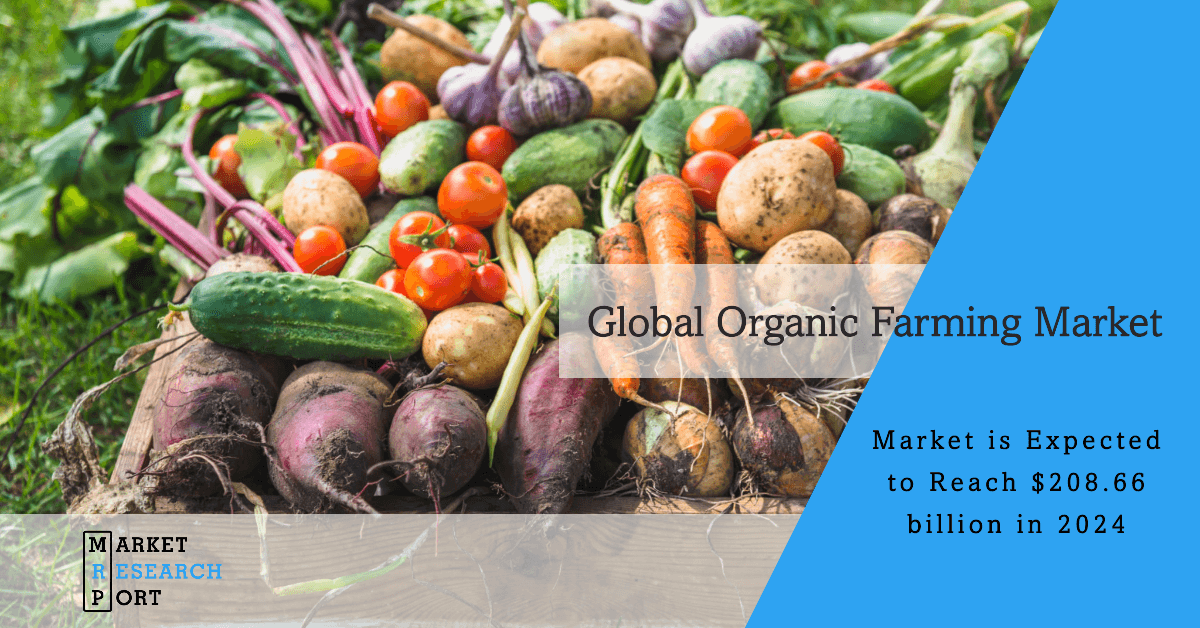
Organic farming is a sustainable agricultural method that avoids or minimizes the use of synthetic additives. This approach emphasizes the health of ecosystems and the quality of produce through natural processes.
– Pure Organic Farming
– Integrated Organic Farming
– Crop Diversity
– Soil Management
– Weed Management
– Controlling Other Organisms
– Fruits and Vegetables
– Cereals and Grains
– Oilseeds and Pulses
– Other Crop Types
The organic farming sector has experienced significant expansion. The market size grew from $187.84 billion in 2023 to $208.66 billion in 2024, representing a compound annual growth rate (CAGR) of 11.1%. This growth is driven by increased consumer awareness, health trends, governmental support, and retailer demand.
Looking ahead, the market is projected to reach $321.79 billion by 2028, with a CAGR of 11.4%. Factors contributing to this growth include concerns over climate change, shifting consumer preferences, advancements in supply chain logistics, and innovations in technology. Key trends include a rise in research and development, technological advancements, increased organic acreage, and the growth of urban agriculture and vertical farming.
Organic farming offers substantial environmental and health advantages. It eschews chemical fertilizers and pesticides, reducing soil and groundwater contamination. It also minimizes reliance on non-renewable resources and supports soil biodiversity. Research from Columbia Climate School highlighted that organic farming can foster 30% more biodiversity, use 45% less energy, and emit 40% less carbon compared to conventional farming. Additionally, organic farming reduces exposure to harmful chemicals, benefiting growers and consumers alike.
The increasing adoption of organic agricultural practices, such as crop rotations and minimum tillage, is fueling market growth. These practices improve soil fertility, structure, and biodiversity, and reduce erosion. The Organic Trade Association reported that in 2021, organic sales in the U.S. reached over $63 billion, with a notable increase in consumer preference for organic products.
Government schemes globally support organic farming due to its health and environmental benefits. For example, India’s Paramparagat Krishi Vikas Yojana (PKVY) and Mission Organic Value Chain Development for the North Eastern Region (MOVCDNER) promote organic practices. Similar initiatives worldwide are expected to further drive market growth.
Innovative products like Mooala Simple, an organic plant-based milk line, are setting new market standards. Despite these advances, challenges such as lower yields compared to conventional farming remain. According to USDA studies, organic farming yields are typically lower, posing potential issues for food security.
In August 2022, the Organic Trade Association collaborated with Sustainable Food Lab to increase the domestic supply of organic grain in the U.S., enhancing market resilience.
Regionally, the Asia-Pacific region was the largest market in 2023, followed by Western Europe. The market spans across various regions including North America, South America, and the Middle East.
The organic farming market encompasses revenues from producing crops and livestock through organic methods, excluding synthetic additives. This includes organic grain, oilseed, fruit, nut, and vegetable farming. The market value reflects revenues from sales and services, excluding resales within the supply chain.
The organic farming market is poised for substantial growth, driven by environmental benefits, consumer demand, and innovative practices. While challenges such as lower yields persist, government support and market innovations continue to shape the future of organic agriculture.
1. Executive Summary
2. Organic Farming Market Characteristics
3. Organic Farming Market Trends And Strategies
4. Organic Farming Market – Macro Economic Scenario
4.1. Impact Of High Inflation On the Market
4.2. Ukraine-Russia War Impact On the Market
4.3. COVID-19 Impact On the Market
5. Global Organic Farming Market Size and Growth
5.1. Global Organic Farming Market Drivers and Restraints
5.1.1. Drivers Of The Market
5.1.2. Restraints Of The Market
5.2. Global Organic Farming Historic Market Size and Growth, 2018 – 2023, Value ($ Billion)
5.3. Global Organic Farming Forecast Market Size and Growth, 2023 – 2028, 2033F, Value ($ Billion)
6. Organic Farming Market Segmentation
6.1. Global Organic Farming Market, Segmentation By Crop Type, Historic and Forecast, 2018-2023, 2023-2028F, 2033F, $ Billion
Fruits And Vegetables
Cereals And Grains
Oilseed And Pulses
Other Crop Types
6.2. Global Organic Farming Market, Segmentation By Farming Type, Historic and Forecast, 2018-2023, 2023-2028F, 2033F, $ Billion
Pure Organic Farming
Integrated Organic Farming
6.3. Global Organic Farming Market, Segmentation By Method, Historic and Forecast, 2018-2023, 2023-2028F, 2033F, $ Billion
Crop Diversity
Soil management
Weed Management
Controlling Other Organisms
7. Organic Farming Market Regional And Country Analysis
7.1. Global Organic Farming Market, Split By Region, Historic and Forecast, 2018-2023, 2023-2028F, 2033F, $ Billion
7.2. Global Organic Farming Market, Split By Country, Historic and Forecast, 2018-2023, 2023-2028F, 2033F, $ Billion
8. Asia-Pacific Organic Farming Market
8.1. Asia-Pacific Organic Farming Market Overview
Region Information, Impact Of COVID-19, Market Information, Background Information, Government Initiatives, Regulations, Regulatory Bodies, Major Associations, Taxes Levied, Corporate Tax Structure, Investments, Major Companies
8.2. Asia-Pacific Organic Farming Market, Segmentation By Crop Type, Historic and Forecast, 2018-2023, 2023-2028F, 2033F, $ Billion
8.3. Asia-Pacific Organic Farming Market, Segmentation By Farming Type, Historic and Forecast, 2018-2023, 2023-2028F, 2033F, $ Billion
8.4. Asia-Pacific Organic Farming Market, Segmentation By Method, Historic and Forecast, 2018-2023, 2023-2028F, 2033F, $ Billion
9. China Organic Farming Market
9.1. China Organic Farming Market Overview
9.2. China Organic Farming Market, Segmentation By Crop Type, Historic and Forecast, 2018-2023, 2023-2028F, 2033F,$ Billion
9.3. China Organic Farming Market, Segmentation By Farming Type, Historic and Forecast, 2018-2023, 2023-2028F, 2033F,$ Billion
9.4. China Organic Farming Market, Segmentation By Method, Historic and Forecast, 2018-2023, 2023-2028F, 2033F,$ Billion
10. India Organic Farming Market
10.1. India Organic Farming Market, Segmentation By Crop Type, Historic and Forecast, 2018-2023, 2023-2028F, 2033F, $ Billion
10.2. India Organic Farming Market, Segmentation By Farming Type, Historic and Forecast, 2018-2023, 2023-2028F, 2033F, $ Billion
10.3. India Organic Farming Market, Segmentation By Method, Historic and Forecast, 2018-2023, 2023-2028F, 2033F, $ Billion
11. Japan Organic Farming Market
11.1. Japan Organic Farming Market Overview
11.2. Japan Organic Farming Market, Segmentation By Crop Type, Historic and Forecast, 2018-2023, 2023-2028F, 2033F, $ Billion
11.3. Japan Organic Farming Market, Segmentation By Farming Type, Historic and Forecast, 2018-2023, 2023-2028F, 2033F, $ Billion
11.4. Japan Organic Farming Market, Segmentation By Method, Historic and Forecast, 2018-2023, 2023-2028F, 2033F, $ Billion
12. Australia Organic Farming Market
12.1. Australia Organic Farming Market, Segmentation By Crop Type, Historic and Forecast, 2018-2023, 2023-2028F, 2033F, $ Billion
12.2. Australia Organic Farming Market, Segmentation By Farming Type, Historic and Forecast, 2018-2023, 2023-2028F, 2033F, $ Billion
12.3. Australia Organic Farming Market, Segmentation By Method, Historic and Forecast, 2018-2023, 2023-2028F, 2033F, $ Billion
13. Indonesia Organic Farming Market
13.1. Indonesia Organic Farming Market, Segmentation By Crop Type, Historic and Forecast, 2018-2023, 2023-2028F, 2033F, $ Billion
13.2. Indonesia Organic Farming Market, Segmentation By Farming Type, Historic and Forecast, 2018-2023, 2023-2028F, 2033F, $ Billion
13.3. Indonesia Organic Farming Market, Segmentation By Method, Historic and Forecast, 2018-2023, 2023-2028F, 2033F, $ Billion
14. South Korea Organic Farming Market
14.1. South Korea Organic Farming Market Overview
14.2. South Korea Organic Farming Market, Segmentation By Crop Type, Historic and Forecast, 2018-2023, 2023-2028F, 2033F, $ Billion
14.3. South Korea Organic Farming Market, Segmentation By Farming Type, Historic and Forecast, 2018-2023, 2023-2028F, 2033F, $ Billion
14.4. South Korea Organic Farming Market, Segmentation By Method, Historic and Forecast, 2018-2023, 2023-2028F, 2033F, $ Billion
15. Western Europe Organic Farming Market
15.1. Western Europe Organic Farming Market Overview
15.2. Western Europe Organic Farming Market, Segmentation By Crop Type, Historic and Forecast, 2018-2023, 2023-2028F, 2033F, $ Billion
15.3. Western Europe Organic Farming Market, Segmentation By Farming Type, Historic and Forecast, 2018-2023, 2023-2028F, 2033F, $ Billion
15.4. Western Europe Organic Farming Market, Segmentation By Method, Historic and Forecast, 2018-2023, 2023-2028F, 2033F, $ Billion
16. UK Organic Farming Market
16.1. UK Organic Farming Market, Segmentation By Crop Type, Historic and Forecast, 2018-2023, 2023-2028F, 2033F, $ Billion
16.2. UK Organic Farming Market, Segmentation By Farming Type, Historic and Forecast, 2018-2023, 2023-2028F, 2033F, $ Billion
16.3. UK Organic Farming Market, Segmentation By Method, Historic and Forecast, 2018-2023, 2023-2028F, 2033F, $ Billion
17. Germany Organic Farming Market
17.1. Germany Organic Farming Market, Segmentation By Crop Type, Historic and Forecast, 2018-2023, 2023-2028F, 2033F, $ Billion
17.2. Germany Organic Farming Market, Segmentation By Farming Type, Historic and Forecast, 2018-2023, 2023-2028F, 2033F, $ Billion
17.3. Germany Organic Farming Market, Segmentation By Method, Historic and Forecast, 2018-2023, 2023-2028F, 2033F, $ Billion
18. France Organic Farming Market
18.5. France Organic Farming Market, Segmentation By Crop Type, Historic and Forecast, 2018-2023, 2023-2028F, 2033F, $ Billion
18.6. France Organic Farming Market, Segmentation By Farming Type, Historic and Forecast, 2018-2023, 2023-2028F, 2033F, $ Billion
18.7. France Organic Farming Market, Segmentation By Method, Historic and Forecast, 2018-2023, 2023-2028F, 2033F, $ Billion
19. Italy Organic Farming Market
19.9. Italy Organic Farming Market, Segmentation By Crop Type, Historic and Forecast, 2018-2023, 2023-2028F, 2033F, $ Billion
19.10. Italy Organic Farming Market, Segmentation By Farming Type, Historic and Forecast, 2018-2023, 2023-2028F, 2033F, $ Billion
19.11. Italy Organic Farming Market, Segmentation By Method, Historic and Forecast, 2018-2023, 2023-2028F, 2033F, $ Billion
20. Spain Organic Farming Market
20.13. Spain Organic Farming Market, Segmentation By Crop Type, Historic and Forecast, 2018-2023, 2023-2028F, 2033F, $ Billion
20.14. Spain Organic Farming Market, Segmentation By Farming Type, Historic and Forecast, 2018-2023, 2023-2028F, 2033F, $ Billion
20.15. Spain Organic Farming Market, Segmentation By Method, Historic and Forecast, 2018-2023, 2023-2028F, 2033F, $ Billion
21. Eastern Europe Organic Farming Market
21.1. Eastern Europe Organic Farming Market Overview
21.2. Eastern Europe Organic Farming Market, Segmentation By Crop Type, Historic and Forecast, 2018-2023, 2023-2028F, 2033F, $ Billion
21.3. Eastern Europe Organic Farming Market, Segmentation By Farming Type, Historic and Forecast, 2018-2023, 2023-2028F, 2033F, $ Billion
21.4. Eastern Europe Organic Farming Market, Segmentation By Method, Historic and Forecast, 2018-2023, 2023-2028F, 2033F, $ Billion
22. Russia Organic Farming Market
22.1. Russia Organic Farming Market, Segmentation By Crop Type, Historic and Forecast, 2018-2023, 2023-2028F, 2033F, $ Billion
22.2. Russia Organic Farming Market, Segmentation By Farming Type, Historic and Forecast, 2018-2023, 2023-2028F, 2033F, $ Billion
22.3. Russia Organic Farming Market, Segmentation By Method, Historic and Forecast, 2018-2023, 2023-2028F, 2033F, $ Billion
23. North America Organic Farming Market
23.1. North America Organic Farming Market Overview
23.2. North America Organic Farming Market, Segmentation By Crop Type, Historic and Forecast, 2018-2023, 2023-2028F, 2033F, $ Billion
23.3. North America Organic Farming Market, Segmentation By Farming Type, Historic and Forecast, 2018-2023, 2023-2028F, 2033F, $ Billion
23.4. North America Organic Farming Market, Segmentation By Method, Historic and Forecast, 2018-2023, 2023-2028F, 2033F, $ Billion
24. USA Organic Farming Market
24.1. USA Organic Farming Market Overview
24.2. USA Organic Farming Market, Segmentation By Crop Type, Historic and Forecast, 2018-2023, 2023-2028F, 2033F, $ Billion
24.3. USA Organic Farming Market, Segmentation By Farming Type, Historic and Forecast, 2018-2023, 2023-2028F, 2033F, $ Billion
24.4. USA Organic Farming Market, Segmentation By Method, Historic and Forecast, 2018-2023, 2023-2028F, 2033F, $ Billion
25. Canada Organic Farming Market
25.1. Canada Organic Farming Market Overview
25.2. Canada Organic Farming Market, Segmentation By Crop Type, Historic and Forecast, 2018-2023, 2023-2028F, 2033F, $ Billion
25.3. Canada Organic Farming Market, Segmentation By Farming Type, Historic and Forecast, 2018-2023, 2023-2028F, 2033F, $ Billion
25.4. Canada Organic Farming Market, Segmentation By Method, Historic and Forecast, 2018-2023, 2023-2028F, 2033F, $ Billion
26. South America Organic Farming Market
26.1. South America Organic Farming Market Overview
26.2. South America Organic Farming Market, Segmentation By Crop Type, Historic and Forecast, 2018-2023, 2023-2028F, 2033F, $ Billion
26.3. South America Organic Farming Market, Segmentation By Farming Type, Historic and Forecast, 2018-2023, 2023-2028F, 2033F, $ Billion
26.4. South America Organic Farming Market, Segmentation By Method, Historic and Forecast, 2018-2023, 2023-2028F, 2033F, $ Billion
27. Brazil Organic Farming Market
27.1. Brazil Organic Farming Market, Segmentation By Crop Type, Historic and Forecast, 2018-2023, 2023-2028F, 2033F, $ Billion
27.2. Brazil Organic Farming Market, Segmentation By Farming Type, Historic and Forecast, 2018-2023, 2023-2028F, 2033F, $ Billion
27.3. Brazil Organic Farming Market, Segmentation By Method, Historic and Forecast, 2018-2023, 2023-2028F, 2033F, $ Billion
28. Middle East Organic Farming Market
28.1. Middle East Organic Farming Market Overview
28.2. Middle East Organic Farming Market, Segmentation By Crop Type, Historic and Forecast, 2018-2023, 2023-2028F, 2033F, $ Billion
28.3. Middle East Organic Farming Market, Segmentation By Farming Type, Historic and Forecast, 2018-2023, 2023-2028F, 2033F, $ Billion
28.4. Middle East Organic Farming Market, Segmentation By Method, Historic and Forecast, 2018-2023, 2023-2028F, 2033F, $ Billion
29. Africa Organic Farming Market
29.1. Africa Organic Farming Market Overview
29.2. Africa Organic Farming Market, Segmentation By Crop Type, Historic and Forecast, 2018-2023, 2023-2028F, 2033F, $ Billion
29.3. Africa Organic Farming Market, Segmentation By Farming Type, Historic and Forecast, 2018-2023, 2023-2028F, 2033F, $ Billion
29.4. Africa Organic Farming Market, Segmentation By Method, Historic and Forecast, 2018-2023, 2023-2028F, 2033F, $ Billion
30. Organic Farming Market Competitive Landscape And Company Profiles
30.1. Organic Farming Market Competitive Landscape
30.2. Organic Farming Market Company Profiles
30.2.1. Dow Chemical Company
30.2.1.1. Overview
30.2.1.2. Products and Services
30.2.1.3. Strategy
30.2.1.4. Financial Performance
30.2.2. BASF SE
30.2.2.1. Overview
30.2.2.2. Products and Services
30.2.2.3. Strategy
30.2.2.4. Financial Performance
30.2.3. Solvay SA
30.2.3.1. Overview
30.2.3.2. Products and Services
30.2.3.3. Strategy
30.2.3.4. Financial Performance
30.2.4. AkzoNobel N.V
30.2.4.1. Overview
30.2.4.2. Products and Services
30.2.4.3. Strategy
30.2.4.4. Financial Performance
30.2.5. Nalco Holding Company
30.2.5.1. Overview
30.2.5.2. Products and Services
30.2.5.3. Strategy
30.2.5.4. Financial Performance
31. Global Organic Farming Market Competitive Benchmarking
32. Global Organic Farming Market Competitive Dashboard
33. Key Mergers And Acquisitions In The Organic Farming Market
34. Organic Farming Market Future Outlook and Potential Analysis
34.1 Organic Farming Market In 2028 – Countries Offering Most New Opportunities
34.2 Organic Farming Market In 2028 – Segments Offering Most New Opportunities
34.3 Organic Farming Market In 2028 – Growth Strategies
34.3.1 Market Trend Based Strategies
34.3.2 Competitor Strategies
35. Appendix
35.1. Abbreviations
35.2. Currencies
35.3. Historic And Forecast Inflation Rates
35.4. Research Inquiries
35.5. The Business Research Company
35.6. Copyright And Disclaimer
Table 1: Global Historic Market Growth, 2018-2023, $ BillionTable 2: Global Forecast Market Growth, 2023-2028F, 2033F, $ Billion
Table 3: Global Organic Farming Market, Segmentation By Crop Type, Historic and Forecast, 2018-2023, 2023-2028F, 2033F, $ Billion
Table 4: Global Organic Farming Market, Segmentation By Farming Type, Historic and Forecast, 2018-2023, 2023-2028F, 2033F, $ Billion
Table 5: Global Organic Farming Market, Segmentation By Method, Historic and Forecast, 2018-2023, 2023-2028F, 2033F, $ Billion
Table 6: Global Organic Farming Market, Split By Region, Historic and Forecast, 2018-2023, 2023-2028F, 2033F, $ Billion
Table 7: Global Organic Farming Market, Split By Country, Historic and Forecast, 2018-2023, 2023-2028F, 2033F, $ Billion
Table 8: Asia-Pacific, Organic Farming Market, Segmentation By Crop Type, Historic and Forecast, 2018-2023, 2023-2028F, 2033F, $ Billion
Table 9: Asia-Pacific, Organic Farming Market, Segmentation By Farming Type, Historic and Forecast, 2018-2023, 2023-2028F, 2033F, $ Billion
Table 10: Asia-Pacific, Organic Farming Market, Segmentation By Method, Historic and Forecast, 2018-2023, 2023-2028F, 2033F, $ Billion
Table 11: China, Organic Farming Market, Segmentation By Crop Type, Historic and Forecast, 2018-2023, 2023-2028F, 2033F, $ Billion
Table 12: China, Organic Farming Market, Segmentation By Farming Type, Historic and Forecast, 2018-2023, 2023-2028F, 2033F, $ Billion
Table 13: China, Organic Farming Market, Segmentation By Method, Historic and Forecast, 2018-2023, 2023-2028F, 2033F, $ Billion
Table 14: India, Organic Farming Market, Segmentation By Crop Type, Historic and Forecast, 2018-2023, 2023-2028F, 2033F, $ Billion
Table 15: India, Organic Farming Market, Segmentation By Farming Type, Historic and Forecast, 2018-2023, 2023-2028F, 2033F, $ Billion
Table 16: India, Organic Farming Market, Segmentation By Method, Historic and Forecast, 2018-2023, 2023-2028F, 2033F, $ Billion
Table 17: Japan, Organic Farming Market, Segmentation By Crop Type, Historic and Forecast, 2018-2023, 2023-2028F, 2033F, $ Billion
Table 18: Japan, Organic Farming Market, Segmentation By Farming Type, Historic and Forecast, 2018-2023, 2023-2028F, 2033F, $ Billion
Table 19: Japan, Organic Farming Market, Segmentation By Method, Historic and Forecast, 2018-2023, 2023-2028F, 2033F, $ Billion
Table 20: Australia, Organic Farming Market, Segmentation By Crop Type, Historic and Forecast, 2018-2023, 2023-2028F, 2033F, $ Billion
Table 21: Australia, Organic Farming Market, Segmentation By Farming Type, Historic and Forecast, 2018-2023, 2023-2028F, 2033F, $ Billion
Table 22: Australia, Organic Farming Market, Segmentation By Method, Historic and Forecast, 2018-2023, 2023-2028F, 2033F, $ Billion
Table 23: Indonesia, Organic Farming Market, Segmentation By Crop Type, Historic and Forecast, 2018-2023, 2023-2028F, 2033F, $ Billion
Table 24: Indonesia, Organic Farming Market, Segmentation By Farming Type, Historic and Forecast, 2018-2023, 2023-2028F, 2033F, $ Billion
Table 25: Indonesia, Organic Farming Market, Segmentation By Method, Historic and Forecast, 2018-2023, 2023-2028F, 2033F, $ Billion
Table 26: South Korea, Organic Farming Market, Segmentation By Crop Type, Historic and Forecast, 2018-2023, 2023-2028F, 2033F, $ Billion
Table 27: South Korea, Organic Farming Market, Segmentation By Farming Type, Historic and Forecast, 2018-2023, 2023-2028F, 2033F, $ Billion
Table 28: South Korea, Organic Farming Market, Segmentation By Method, Historic and Forecast, 2018-2023, 2023-2028F, 2033F, $ Billion
Table 29: Western Europe, Organic Farming Market, Segmentation By Crop Type, Historic and Forecast, 2018-2023, 2023-2028F, 2033F, $ Billion
Table 30: Western Europe, Organic Farming Market, Segmentation By Farming Type, Historic and Forecast, 2018-2023, 2023-2028F, 2033F, $ Billion
Table 31: Western Europe, Organic Farming Market, Segmentation By Method, Historic and Forecast, 2018-2023, 2023-2028F, 2033F, $ Billion
Table 32: UK, Organic Farming Market, Segmentation By Crop Type, Historic and Forecast, 2018-2023, 2023-2028F, 2033F, $ Billion
Table 33: UK, Organic Farming Market, Segmentation By Farming Type, Historic and Forecast, 2018-2023, 2023-2028F, 2033F, $ Billion
Table 34: UK, Organic Farming Market, Segmentation By Method, Historic and Forecast, 2018-2023, 2023-2028F, 2033F, $ Billion
Table 35: Germany, Organic Farming Market, Segmentation By Crop Type, Historic and Forecast, 2018-2023, 2023-2028F, 2033F, $ Billion
Table 36: Germany, Organic Farming Market, Segmentation By Farming Type, Historic and Forecast, 2018-2023, 2023-2028F, 2033F, $ Billion
Table 37: Germany, Organic Farming Market, Segmentation By Method, Historic and Forecast, 2018-2023, 2023-2028F, 2033F, $ Billion
Table 38: France, Organic Farming Market, Segmentation By Crop Type, Historic and Forecast, 2018-2023, 2023-2028F, 2033F, $ Billion
Table 39: France, Organic Farming Market, Segmentation By Farming Type, Historic and Forecast, 2018-2023, 2023-2028F, 2033F, $ Billion
Table 40: France, Organic Farming Market, Segmentation By Method, Historic and Forecast, 2018-2023, 2023-2028F, 2033F, $ Billion
Table 41: Italy, Organic Farming Market, Segmentation By Crop Type, Historic and Forecast, 2018-2023, 2023-2028F, 2033F, $ Billion
Table 42: Italy, Organic Farming Market, Segmentation By Farming Type, Historic and Forecast, 2018-2023, 2023-2028F, 2033F, $ Billion
Table 43: Italy, Organic Farming Market, Segmentation By Method, Historic and Forecast, 2018-2023, 2023-2028F, 2033F, $ Billion
Table 44: Spain, Organic Farming Market, Segmentation By Crop Type, Historic and Forecast, 2018-2023, 2023-2028F, 2033F, $ Billion
Table 45: Spain, Organic Farming Market, Segmentation By Farming Type, Historic and Forecast, 2018-2023, 2023-2028F, 2033F, $ Billion
Table 46: Spain, Organic Farming Market, Segmentation By Method, Historic and Forecast, 2018-2023, 2023-2028F, 2033F, $ Billion
Table 47: Eastern Europe, Organic Farming Market, Segmentation By Crop Type, Historic and Forecast, 2018-2023, 2023-2028F, 2033F, $ Billion
Table 48: Eastern Europe, Organic Farming Market, Segmentation By Farming Type, Historic and Forecast, 2018-2023, 2023-2028F, 2033F, $ Billion
Table 49: Eastern Europe, Organic Farming Market, Segmentation By Method, Historic and Forecast, 2018-2023, 2023-2028F, 2033F, $ Billion
Table 50: Russia, Organic Farming Market, Segmentation By Crop Type, Historic and Forecast, 2018-2023, 2023-2028F, 2033F, $ Billion
Table 51: Russia, Organic Farming Market, Segmentation By Farming Type, Historic and Forecast, 2018-2023, 2023-2028F, 2033F, $ Billion
Table 52: Russia, Organic Farming Market, Segmentation By Method, Historic and Forecast, 2018-2023, 2023-2028F, 2033F, $ Billion
Table 53: North America, Organic Farming Market, Segmentation By Crop Type, Historic and Forecast, 2018-2023, 2023-2028F, 2033F, $ Billion
Table 54: North America, Organic Farming Market, Segmentation By Farming Type, Historic and Forecast, 2018-2023, 2023-2028F, 2033F, $ Billion
Table 55: North America, Organic Farming Market, Segmentation By Method, Historic and Forecast, 2018-2023, 2023-2028F, 2033F, $ Billion
Table 56: USA, Organic Farming Market, Segmentation By Crop Type, Historic and Forecast, 2018-2023, 2023-2028F, 2033F, $ Billion
Table 57: USA, Organic Farming Market, Segmentation By Farming Type, Historic and Forecast, 2018-2023, 2023-2028F, 2033F, $ Billion
Table 58: USA, Organic Farming Market, Segmentation By Method, Historic and Forecast, 2018-2023, 2023-2028F, 2033F, $ Billion
Table 59: Canada, Organic Farming Market, Segmentation By Crop Type, Historic and Forecast, 2018-2023, 2023-2028F, 2033F, $ Billion
Table 60: Canada, Organic Farming Market, Segmentation By Farming Type, Historic and Forecast, 2018-2023, 2023-2028F, 2033F, $ Billion
Table 61: Canada, Organic Farming Market, Segmentation By Method, Historic and Forecast, 2018-2023, 2023-2028F, 2033F, $ Billion
Table 62: South America, Organic Farming Market, Segmentation By Crop Type, Historic and Forecast, 2018-2023, 2023-2028F, 2033F, $ Billion
Table 63: South America, Organic Farming Market, Segmentation By Farming Type, Historic and Forecast, 2018-2023, 2023-2028F, 2033F, $ Billion
Table 64: South America, Organic Farming Market, Segmentation By Method, Historic and Forecast, 2018-2023, 2023-2028F, 2033F, $ Billion
Table 65: Brazil, Organic Farming Market, Segmentation By Crop Type, Historic and Forecast, 2018-2023, 2023-2028F, 2033F, $ Billion
Table 66: Brazil, Organic Farming Market, Segmentation By Farming Type, Historic and Forecast, 2018-2023, 2023-2028F, 2033F, $ Billion
Table 67: Brazil, Organic Farming Market, Segmentation By Method, Historic and Forecast, 2018-2023, 2023-2028F, 2033F, $ Billion
Table 68: Middle East, Organic Farming Market, Segmentation By Crop Type, Historic and Forecast, 2018-2023, 2023-2028F, 2033F, $ Billion
Table 69: Middle East, Organic Farming Market, Segmentation By Farming Type, Historic and Forecast, 2018-2023, 2023-2028F, 2033F, $ Billion
Table 70: Middle East, Organic Farming Market, Segmentation By Method, Historic and Forecast, 2018-2023, 2023-2028F, 2033F, $ Billion
Table 71: Africa, Organic Farming Market, Segmentation By Crop Type, Historic and Forecast, 2018-2023, 2023-2028F, 2033F, $ Billion
Table 72: Africa, Organic Farming Market, Segmentation By Farming Type, Historic and Forecast, 2018-2023, 2023-2028F, 2033F, $ Billion
Table 73: Africa, Organic Farming Market, Segmentation By Method, Historic and Forecast, 2018-2023, 2023-2028F, 2033F, $ Billion
Table 74: Dow Chemical Company Financial Performance
Table 75: BASF SE Financial Performance
Table 76: Solvay SA Financial Performance
Table 77: AkzoNobel N.V Financial Performance
Table 78: Nalco Holding Company Financial Performance
Figure 1: Global Historic Market Growth, 2018-2023, $ BillionFigure 2: Global Forecast Market Growth, 2023-2028F, 2033F, $ Billion
Figure 3: Global Organic Farming Market, Segmentation By Crop Type, Historic and Forecast, 2018-2023, 2023-2028F, 2033F, $ Billion
Figure 4: Global Organic Farming Market, Segmentation By Farming Type, Historic and Forecast, 2018-2023, 2023-2028F, 2033F, $ Billion
Figure 5: Global Organic Farming Market, Segmentation By Method, Historic and Forecast, 2018-2023, 2023-2028F, 2033F, $ Billion
Figure 6: Global Organic Farming Market, Split By Region, Historic and Forecast, 2018-2023, 2023-2028F, 2033F, $ Billion
Figure 7: Global Organic Farming Market, Split By Country, Historic and Forecast, 2018-2023, 2023-2028F, 2033F, $ Billion
Figure 8: Asia-Pacific, Organic Farming Market, Segmentation By Crop Type, Historic and Forecast, 2018-2023, 2023-2028F, 2033F, $ Billion
Figure 9: Asia-Pacific, Organic Farming Market, Segmentation By Farming Type, Historic and Forecast, 2018-2023, 2023-2028F, 2033F, $ Billion
Figure 10: Asia-Pacific, Organic Farming Market, Segmentation By Method, Historic and Forecast, 2018-2023, 2023-2028F, 2033F, $ Billion
Figure 11: China, Organic Farming Market, Segmentation By Crop Type, Historic and Forecast, 2018-2023, 2023-2028F, 2033F, $ Billion
Figure 12: China, Organic Farming Market, Segmentation By Farming Type, Historic and Forecast, 2018-2023, 2023-2028F, 2033F, $ Billion
Figure 13: China, Organic Farming Market, Segmentation By Method, Historic and Forecast, 2018-2023, 2023-2028F, 2033F, $ Billion
Figure 14: India, Organic Farming Market, Segmentation By Crop Type, Historic and Forecast, 2018-2023, 2023-2028F, 2033F, $ Billion
Figure 15: India, Organic Farming Market, Segmentation By Farming Type, Historic and Forecast, 2018-2023, 2023-2028F, 2033F, $ Billion
Figure 16: India, Organic Farming Market, Segmentation By Method, Historic and Forecast, 2018-2023, 2023-2028F, 2033F, $ Billion
Figure 17: Japan, Organic Farming Market, Segmentation By Crop Type, Historic and Forecast, 2018-2023, 2023-2028F, 2033F, $ Billion
Figure 18: Japan, Organic Farming Market, Segmentation By Farming Type, Historic and Forecast, 2018-2023, 2023-2028F, 2033F, $ Billion
Figure 19: Japan, Organic Farming Market, Segmentation By Method, Historic and Forecast, 2018-2023, 2023-2028F, 2033F, $ Billion
Figure 20: Australia, Organic Farming Market, Segmentation By Crop Type, Historic and Forecast, 2018-2023, 2023-2028F, 2033F, $ Billion
Figure 21: Australia, Organic Farming Market, Segmentation By Farming Type, Historic and Forecast, 2018-2023, 2023-2028F, 2033F, $ Billion
Figure 22: Australia, Organic Farming Market, Segmentation By Method, Historic and Forecast, 2018-2023, 2023-2028F, 2033F, $ Billion
Figure 23: Indonesia, Organic Farming Market, Segmentation By Crop Type, Historic and Forecast, 2018-2023, 2023-2028F, 2033F, $ Billion
Figure 24: Indonesia, Organic Farming Market, Segmentation By Farming Type, Historic and Forecast, 2018-2023, 2023-2028F, 2033F, $ Billion
Figure 25: Indonesia, Organic Farming Market, Segmentation By Method, Historic and Forecast, 2018-2023, 2023-2028F, 2033F, $ Billion
Figure 26: South Korea, Organic Farming Market, Segmentation By Crop Type, Historic and Forecast, 2018-2023, 2023-2028F, 2033F, $ Billion
Figure 27: South Korea, Organic Farming Market, Segmentation By Farming Type, Historic and Forecast, 2018-2023, 2023-2028F, 2033F, $ Billion
Figure 28: South Korea, Organic Farming Market, Segmentation By Method, Historic and Forecast, 2018-2023, 2023-2028F, 2033F, $ Billion
Figure 29: Western Europe, Organic Farming Market, Segmentation By Crop Type, Historic and Forecast, 2018-2023, 2023-2028F, 2033F, $ Billion
Figure 30: Western Europe, Organic Farming Market, Segmentation By Farming Type, Historic and Forecast, 2018-2023, 2023-2028F, 2033F, $ Billion
Figure 31: Western Europe, Organic Farming Market, Segmentation By Method, Historic and Forecast, 2018-2023, 2023-2028F, 2033F, $ Billion
Figure 32: UK, Organic Farming Market, Segmentation By Crop Type, Historic and Forecast, 2018-2023, 2023-2028F, 2033F, $ Billion
Figure 33: UK, Organic Farming Market, Segmentation By Farming Type, Historic and Forecast, 2018-2023, 2023-2028F, 2033F, $ Billion
Figure 34: UK, Organic Farming Market, Segmentation By Method, Historic and Forecast, 2018-2023, 2023-2028F, 2033F, $ Billion
Figure 35: Germany, Organic Farming Market, Segmentation By Crop Type, Historic and Forecast, 2018-2023, 2023-2028F, 2033F, $ Billion
Figure 36: Germany, Organic Farming Market, Segmentation By Farming Type, Historic and Forecast, 2018-2023, 2023-2028F, 2033F, $ Billion
Figure 37: Germany, Organic Farming Market, Segmentation By Method, Historic and Forecast, 2018-2023, 2023-2028F, 2033F, $ Billion
Figure 38: France, Organic Farming Market, Segmentation By Crop Type, Historic and Forecast, 2018-2023, 2023-2028F, 2033F, $ Billion
Figure 39: France, Organic Farming Market, Segmentation By Farming Type, Historic and Forecast, 2018-2023, 2023-2028F, 2033F, $ Billion
Figure 40: France, Organic Farming Market, Segmentation By Method, Historic and Forecast, 2018-2023, 2023-2028F, 2033F, $ Billion
Figure 41: Italy, Organic Farming Market, Segmentation By Crop Type, Historic and Forecast, 2018-2023, 2023-2028F, 2033F, $ Billion
Figure 42: Italy, Organic Farming Market, Segmentation By Farming Type, Historic and Forecast, 2018-2023, 2023-2028F, 2033F, $ Billion
Figure 43: Italy, Organic Farming Market, Segmentation By Method, Historic and Forecast, 2018-2023, 2023-2028F, 2033F, $ Billion
Figure 44: Spain, Organic Farming Market, Segmentation By Crop Type, Historic and Forecast, 2018-2023, 2023-2028F, 2033F, $ Billion
Figure 45: Spain, Organic Farming Market, Segmentation By Farming Type, Historic and Forecast, 2018-2023, 2023-2028F, 2033F, $ Billion
Figure 46: Spain, Organic Farming Market, Segmentation By Method, Historic and Forecast, 2018-2023, 2023-2028F, 2033F, $ Billion
Figure 47: Eastern Europe, Organic Farming Market, Segmentation By Crop Type, Historic and Forecast, 2018-2023, 2023-2028F, 2033F, $ Billion
Figure 48: Eastern Europe, Organic Farming Market, Segmentation By Farming Type, Historic and Forecast, 2018-2023, 2023-2028F, 2033F, $ Billion
Figure 49: Eastern Europe, Organic Farming Market, Segmentation By Method, Historic and Forecast, 2018-2023, 2023-2028F, 2033F, $ Billion
Figure 50: Russia, Organic Farming Market, Segmentation By Crop Type, Historic and Forecast, 2018-2023, 2023-2028F, 2033F, $ Billion
Figure 51: Russia, Organic Farming Market, Segmentation By Farming Type, Historic and Forecast, 2018-2023, 2023-2028F, 2033F, $ Billion
Figure 52: Russia, Organic Farming Market, Segmentation By Method, Historic and Forecast, 2018-2023, 2023-2028F, 2033F, $ Billion
Figure 53: North America, Organic Farming Market, Segmentation By Crop Type, Historic and Forecast, 2018-2023, 2023-2028F, 2033F, $ Billion
Figure 54: North America, Organic Farming Market, Segmentation By Farming Type, Historic and Forecast, 2018-2023, 2023-2028F, 2033F, $ Billion
Figure 55: North America, Organic Farming Market, Segmentation By Method, Historic and Forecast, 2018-2023, 2023-2028F, 2033F, $ Billion
Figure 56: USA, Organic Farming Market, Segmentation By Crop Type, Historic and Forecast, 2018-2023, 2023-2028F, 2033F, $ Billion
Figure 57: USA, Organic Farming Market, Segmentation By Farming Type, Historic and Forecast, 2018-2023, 2023-2028F, 2033F, $ Billion
Figure 58: USA, Organic Farming Market, Segmentation By Method, Historic and Forecast, 2018-2023, 2023-2028F, 2033F, $ Billion
Figure 59: Canada, Organic Farming Market, Segmentation By Crop Type, Historic and Forecast, 2018-2023, 2023-2028F, 2033F, $ Billion
Figure 60: Canada, Organic Farming Market, Segmentation By Farming Type, Historic and Forecast, 2018-2023, 2023-2028F, 2033F, $ Billion
Figure 61: Canada, Organic Farming Market, Segmentation By Method, Historic and Forecast, 2018-2023, 2023-2028F, 2033F, $ Billion
Figure 62: South America, Organic Farming Market, Segmentation By Crop Type, Historic and Forecast, 2018-2023, 2023-2028F, 2033F, $ Billion
Figure 63: South America, Organic Farming Market, Segmentation By Farming Type, Historic and Forecast, 2018-2023, 2023-2028F, 2033F, $ Billion
Figure 64: South America, Organic Farming Market, Segmentation By Method, Historic and Forecast, 2018-2023, 2023-2028F, 2033F, $ Billion
Figure 65: Brazil, Organic Farming Market, Segmentation By Crop Type, Historic and Forecast, 2018-2023, 2023-2028F, 2033F, $ Billion
Figure 66: Brazil, Organic Farming Market, Segmentation By Farming Type, Historic and Forecast, 2018-2023, 2023-2028F, 2033F, $ Billion
Figure 67: Brazil, Organic Farming Market, Segmentation By Method, Historic and Forecast, 2018-2023, 2023-2028F, 2033F, $ Billion
Figure 68: Middle East, Organic Farming Market, Segmentation By Crop Type, Historic and Forecast, 2018-2023, 2023-2028F, 2033F, $ Billion
Figure 69: Middle East, Organic Farming Market, Segmentation By Farming Type, Historic and Forecast, 2018-2023, 2023-2028F, 2033F, $ Billion
Figure 70: Middle East, Organic Farming Market, Segmentation By Method, Historic and Forecast, 2018-2023, 2023-2028F, 2033F, $ Billion
Figure 71: Africa, Organic Farming Market, Segmentation By Crop Type, Historic and Forecast, 2018-2023, 2023-2028F, 2033F, $ Billion
Figure 72: Africa, Organic Farming Market, Segmentation By Farming Type, Historic and Forecast, 2018-2023, 2023-2028F, 2033F, $ Billion
Figure 73: Africa, Organic Farming Market, Segmentation By Method, Historic and Forecast, 2018-2023, 2023-2028F, 2033F, $ Billion
Figure 74: Dow Chemical Company Financial Performance
Figure 75: BASF SE Financial Performance
Figure 76: Solvay SA Financial Performance
Figure 77: AkzoNobel N.V Financial Performance
Figure 78: Nalco Holding Company Financial Performance






